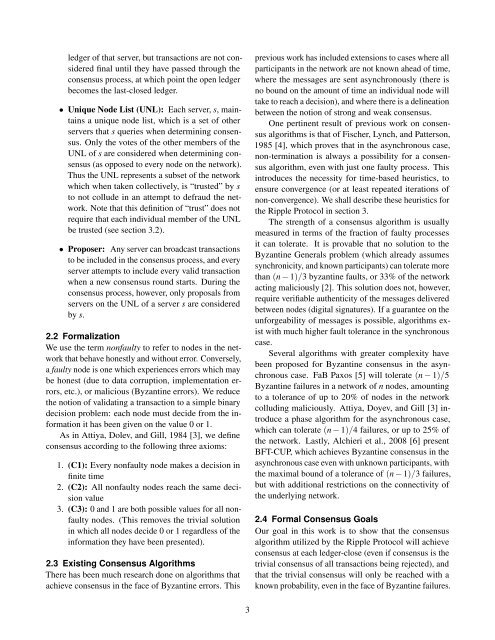Whitepaper - Ripple With Cover
Create successful ePaper yourself
Turn your PDF publications into a flip-book with our unique Google optimized e-Paper software.
ledger of that server, but transactions are not considered<br />
final until they have passed through the<br />
consensus process, at which point the open ledger<br />
becomes the last-closed ledger.<br />
• Unique Node List (UNL): Each server, s, maintains<br />
a unique node list, which is a set of other<br />
servers that s queries when determining consensus.<br />
Only the votes of the other members of the<br />
UNL of s are considered when determining consensus<br />
(as opposed to every node on the network).<br />
Thus the UNL represents a subset of the network<br />
which when taken collectively, is “trusted” by s<br />
to not collude in an attempt to defraud the network.<br />
Note that this definition of “trust” does not<br />
require that each individual member of the UNL<br />
be trusted (see section 3.2).<br />
• Proposer: Any server can broadcast transactions<br />
to be included in the consensus process, and every<br />
server attempts to include every valid transaction<br />
when a new consensus round starts. During the<br />
consensus process, however, only proposals from<br />
servers on the UNL of a server s are considered<br />
by s.<br />
2.2 Formalization<br />
We use the term nonfaulty to refer to nodes in the network<br />
that behave honestly and without error. Conversely,<br />
a faulty node is one which experiences errors which may<br />
be honest (due to data corruption, implementation errors,<br />
etc.), or malicious (Byzantine errors). We reduce<br />
the notion of validating a transaction to a simple binary<br />
decision problem: each node must decide from the information<br />
it has been given on the value 0 or 1.<br />
As in Attiya, Dolev, and Gill, 1984 [3], we define<br />
consensus according to the following three axioms:<br />
1. (C1): Every nonfaulty node makes a decision in<br />
finite time<br />
2. (C2): All nonfaulty nodes reach the same decision<br />
value<br />
3. (C3): 0 and 1 are both possible values for all nonfaulty<br />
nodes. (This removes the trivial solution<br />
in which all nodes decide 0 or 1 regardless of the<br />
information they have been presented).<br />
2.3 Existing Consensus Algorithms<br />
There has been much research done on algorithms that<br />
achieve consensus in the face of Byzantine errors. This<br />
previous work has included extensions to cases where all<br />
participants in the network are not known ahead of time,<br />
where the messages are sent asynchronously (there is<br />
no bound on the amount of time an individual node will<br />
take to reach a decision), and where there is a delineation<br />
between the notion of strong and weak consensus.<br />
One pertinent result of previous work on consensus<br />
algorithms is that of Fischer, Lynch, and Patterson,<br />
1985 [4], which proves that in the asynchronous case,<br />
non-termination is always a possibility for a consensus<br />
algorithm, even with just one faulty process. This<br />
introduces the necessity for time-based heuristics, to<br />
ensure convergence (or at least repeated iterations of<br />
non-convergence). We shall describe these heuristics for<br />
the <strong>Ripple</strong> Protocol in section 3.<br />
The strength of a consensus algorithm is usually<br />
measured in terms of the fraction of faulty processes<br />
it can tolerate. It is provable that no solution to the<br />
Byzantine Generals problem (which already assumes<br />
synchronicity, and known participants) can tolerate more<br />
than (n − 1)/3 byzantine faults, or 33% of the network<br />
acting maliciously [2]. This solution does not, however,<br />
require verifiable authenticity of the messages delivered<br />
between nodes (digital signatures). If a guarantee on the<br />
unforgeability of messages is possible, algorithms exist<br />
with much higher fault tolerance in the synchronous<br />
case.<br />
Several algorithms with greater complexity have<br />
been proposed for Byzantine consensus in the asynchronous<br />
case. FaB Paxos [5] will tolerate (n − 1)/5<br />
Byzantine failures in a network of n nodes, amounting<br />
to a tolerance of up to 20% of nodes in the network<br />
colluding maliciously. Attiya, Doyev, and Gill [3] introduce<br />
a phase algorithm for the asynchronous case,<br />
which can tolerate (n − 1)/4 failures, or up to 25% of<br />
the network. Lastly, Alchieri et al., 2008 [6] present<br />
BFT-CUP, which achieves Byzantine consensus in the<br />
asynchronous case even with unknown participants, with<br />
the maximal bound of a tolerance of (n − 1)/3 failures,<br />
but with additional restrictions on the connectivity of<br />
the underlying network.<br />
2.4 Formal Consensus Goals<br />
Our goal in this work is to show that the consensus<br />
algorithm utilized by the <strong>Ripple</strong> Protocol will achieve<br />
consensus at each ledger-close (even if consensus is the<br />
trivial consensus of all transactions being rejected), and<br />
that the trivial consensus will only be reached with a<br />
known probability, even in the face of Byzantine failures.<br />
3

















